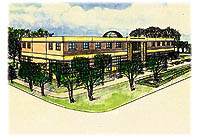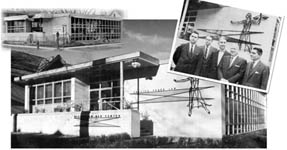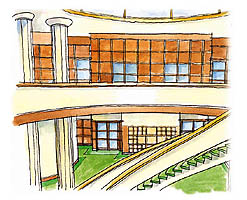New Facility Reflects Bar's National Reputation of Service
When the State Bar of Wisconsin moves into its new facility in 1999,
it will finally have a physical home that reflects its first-rate
national reputation for service to members, level of member
participation, product and staff quality, and commitment to the
public.
By Dianne Molvig
In April 1958 Philip Habermann, then State Bar executive director,
sat in the Bar's three-room rented office at 122 W. Washington Avenue,
Madison, and composed a letter in which he made a few prognostications.
At the time, the Bar was only a few months away from moving into its
newly constructed headquarters and current location at 402 W. Wilson
Street. The new building "will have been enlarged by the addition of a
second story in 1970," Habermann predicted, "and in the year 2000 the
offices will have moved to new and larger quarters."
 Habermann wasn't off by much. A second story to
the West Wilson Street building was added in 1969, and if all goes
according to plan, the Bar will be moving into a new, larger
headquarters in 1999.
Habermann wasn't off by much. A second story to
the West Wilson Street building was added in 1969, and if all goes
according to plan, the Bar will be moving into a new, larger
headquarters in 1999.
As State Bar Past President Steve Sorenson sees it, the new State Bar
Center will align the Bar's physical facility with its national
reputation. "The Wisconsin Bar is noted as one of the top bar
associations in the nation, in terms of its products, its staff, and its
commitment to its members and the public," Sorenson says. "But we've
been chiseling away at our strengths by the limitations imposed by the
physical structure."
Greater demands placed upon the profession in an increasingly
competitive marketplace challenge the Bar to offer its members new
information and efficient ways to serve clients. These challenges have
led to a new State Bar Center - as a place to efficiently address the
needs of a growing membership and a gathering place for Wisconsin's
legal community.
The new Center will be a 40,000-square-foot facility located in the
American Center Office Park near the intersection of Highway 151 and
Interstate 90/94 on Madison's northeast side. The ground-breaking
ceremony took place on July 2, and the building should be ready for
occupancy by next summer.
The Bar's first home
Building a new center is a major step for the Bar today, just as it
was 40 years ago. In 1958 when Habermann wrote his projections, the Bar
had been in its small rented office a block off the Capitol Square for
10 years. Before that, the Bar had had no home of its own. The Bar was
founded in 1878, and during its first 42 years, its headquarters were
transient, residing in the office of whoever was serving as the
association's secretary. That arrangement continued until 1920, when the
state law librarian's office became the Bar's quarters. When Habermann
came on board in 1948 as the Bar's first employee, the time seemed right
for the association to have its own office.
Eventually that, too, proved inadequate. "We had only 2,200 members
when I opened the office," recalls Habermann, a Bar member since 1947,
who's now retired and residing in Madison. "But we were admitting 500 to
700 new lawyers a year, as a lot of the post-war classes were coming
along. By 1954 or '55, we faced the necessity of renting larger quarters
or getting a building of our own."

The Bar was formed in 1878, but it wasn't until 1958 that the
association moved into its own permanent home to support 6,700 members.
The decision to build an office received widespread member support and,
then as now, a capital campaign helped fund construction of the
one-story building.
Above, right: (from left) Executive Director Philip S. Habermann,
Herbert L. Terwilliger, U.S. Supreme Court Justice Tom C. Clark, Charles
L. Goldberg, and Francis J. Wilcox took part in dedicating the current
Bar Center at a ceremony in 1958.
Continuing to respond to requests for more and different services by
a growing membership, it wasn't long before the Bar needed more space.
The Bar Center underwent extensive remodeling and additional
construction over the years, finally bringing the building to its
current 20,000 square feet. As early as 10 years ago the Facilities
Committee recognized the Bar would eventually outgrow its current
facility if programming were to keep pace with its membership - now at
19,582.
The decision for the Bar to build its own facility - at that time
only the fourth bar organization in the country to do so - won favor
with little opposition, as Habermann recalls. Others from that era also
remember the decision to build as one having widespread support. Eau
Claire attorney Francis Wilcox, a Bar member since 1933, says that
owning the Bar building "gave us a sense of solidarity and permanency."
Fellow attorney Robert B.L. Murphy of Madison, a Bar member since 1932,
adds, "It meant having a place for committees to meet, who before that
had to meet in hotels and committee members' offices. We had a place of
our own. It was like owning a home, by analogy."
The Wilson Street facility, which included some 3,400 square feet of
office space on the main floor plus a full basement, was easily more
than six times the size of the rented office Habermann and his four
coworkers had moved from. "Our staff almost rattled around in the new
building," Habermann says, "and it was wonderful."
Benefits Habermann noticed right away included the availability of
meeting space for Bar committees and a tremendous boost in the
association's capacity to stay in touch with its then 6,700 members. New
equipment for printing, addressing, and mailing - which wouldn't have
fit in the old office - allowed the Bar to become a more effective
communications hub.
Growth cycles
The staff's perception of "rattling around" didn't last long. Within
a couple of years the staff grew to be eight or 10, Habermann recalls.
Staff had expanded to serve a growing Bar membership, which took a
substantial jump when the Wisconsin Supreme Court ordered integration of
the Bar in December 1958 following a two-year trial period of
integration. Thereafter, anyone practicing law in Wisconsin had to be a
Bar member. "All of a sudden we had a membership of 6,000 or 7,000,"
Habermann says. "Thank God for the new building."

Continuing to respond to requests for more and different services by
a growing membership, it wasn't long before the Bar needed more space.
The Bar Center underwent extensive remodeling and additional
construction over the years, finally bringing the building to its
current 20,000 square feet. As early as 10 years ago the Facilities
Committee recognized the Bar would eventually outgrow its current
facility if programming were to keep pace with its membership - now at
19,582.
By 1966, with a membership of 7,431, needs for additional parking and
interior space had become evident. In 1969 a second story was added to
the building, which had been engineered to structurally bear another
floor, and neighboring houses were purchased, razed, and replaced with
parking lots.
New continuing education programs, launched in 1970 to serve the
Bar's then 8,302 members, translated into burgeoning needs for space to
store materials, which led to construction of an underground storage
room below the rear parking lot. Other Bar programs and services also
expanded. In 1981, with membership at 12,496, an addition was built,
bringing the facility to its current 20,000 square feet. Since then, the
building interior has gone through repeated cycles of remodeling and
reconfiguring - plus renting outside space for storage and printing - to
accommodate a growing Bar, now with 19,582 members, and its staff.
"It's become a honeycomb," says Stevens Point attorney Gerald
O'Brien, who chairs the Bar's Facilities Committee. "I got started in
Bar activities in the early 1980s, and back then you could get around in
there. But little by little over the years, it's become impossible. How
does anybody work in there? People's workspaces have been subdivided
down to telephone-booth size, and storage space is practically zero. To
a person who visited the Center on a regular basis over that period of
time, it was really obvious how bad it was getting."
Making cramped office space even more problematic is the nature of
the work most of the 85 full-time-equivalent State Bar employees
perform, points out Stephen Smay, executive director. "We have a high
level of noise and commotion because we have so many people crammed
together," Smay says. "A high percentage of people who work at the Bar
are on the telephone, coordinating meetings and doing things other than
quietly sitting at their desks."
Meeting and conference rooms long ago were sacrificed to create work
areas. Many meetings that once could be held at the Bar Center now have
to be convened at hotels and other locations, creating inefficiencies
for members and staff. "That involves the staff going someplace else,"
Smay notes, "and getting the materials organized to go someplace else,
and paying rental fees."
Moving on

The new Bar Center's first floor highlights space for member use,
including: Assembly Halls A, B, and C, which can be used individually or
combined for larger gatherings; a hands-on computer training center; a
conference room (the other two conference rooms and boardroom are on the
second floor); and the open central area for social gatherings and
networking opportunities. The Center also includes workspace for member
use.
View Larger
Image.
The decision to build a new Bar Center was 10 years in the making,
according to O'Brien. He points out that Facilities Committee
recommendations in support of a new building date at least that far
back. In compliance with the Board of Governors' requests, over the
years the committee has explored various options for dealing with the
space crunch.
Expanding the current building laterally had to be ruled out because
of neighborhood zoning restrictions, and growing upward by adding yet
another full floor proved impossible due to structural inadequacies of
the older part of the building. After evaluating existing facilities
available for purchase and other sites for new construction, the
committee recommended and the Board of Governors approved the American
Center site earlier this year. (For a more complete account of events
leading up to the final decision, see articles in the December
1997 Wisconsin Lawyer and the May
1998 Newsletter.)
Still, some have voiced concern about the Bar moving so far away from
the political heart of Madison, the Capitol building. Will the Bar's
influence in governmental affairs wane? Smay doesn't believe so, any
more than being located at more remote sites has lessened the political
clout of other organizations, such as the Wisconsin Education
Association Council or the Wisconsin Realtors® Association.
"We are going to have a presence downtown, no question about that,"
Smay explains, noting that renting a small office has been figured into
the expansion project budget. The office will be for occasional use by
staff lobbyists and others who have business downtown. "We're not
banishing anybody to a satellite office," Smay adds, "and we're not
splitting up staff. We're simply going to provide some desk space for
people who are downtown for whatever reason, where they can work while
waiting for their next appointment. It's not going to be anybody's
assignment to be downtown on a full-time basis."
At double the size of the West Wilson Street building, the new
facility will relieve the "rabbit warren" atmosphere of the current
offices, says State Bar President Susan Steingass. Not only will staff
gain the elbow room they need to better perform member services,
Steingass notes, but for members themselves the additional space means
room for CLE programs, meetings, conferences, social events - and plenty
of available parking. Being close to Interstate 90/94 and Highway 151
provides easier access to the Bar Center for out-of-town members. Rooms
also will be set aside for out-of-town attorneys who wish to work or
conduct depositions while they're in Madison. And a computer training
lab will give members a hands-on environment in which to learn about new
technology.
"We want to make this a place that's far more usable in terms of
space, in terms of location, and in terms of the nature of the facility
- for everybody," Steingass says. "I really think the new Bar Center is
a move toward inclusiveness. There's more space for everyone, more room
to grow. It's good for all of us."

The names of contributors pledging at the Founders Club level of
$10,000 or more will be engraved on the second floor galleria.
Additional recognition includes naming opportunities and an honor roll
book, the Recognition Wall, and the 100 % Club.
Recognition opportunities abound to thank contributors who help fund
the new Center. The names of those pledging $500 or more will appear on
the Recognition Wall located outside the Assembly Halls in the main
floor rotunda. The names of 100% Club participants also will be engraved
on a wall on the main level to recognize all entities pledging at least
$300 per attorney.
Design highlights
Creating a building design that works for all user groups - including
Bar members, other visitors, and staff - was the task set before
Milwaukee architect Louis Wasserman, who previously won a design
competition for his conversion of the old Skylight Opera into new
headquarters for the Milwaukee Bar Association.
The new State Bar Center will have two stories, plus a lower level.
The main floor's north wing will have CLE classrooms, with offices in
the south wing. The second floor will contain additional offices and
meeting rooms. The floor plan will combine open work space and enclosed
offices, allowing flexibility to adapt to future needs. The lower level
will house one administrative department, plus a printing facility, mail
room, order-fulfillment area, exercise room, and commons area. Although
the lower level is the building's basement, it will be raised
sufficiently to allow in plenty of daylight.
Natural lighting will be a key feature in the building, especially in
the reception area, which is a two-story atrium topped with a
26-foot-diameter dome made of translucent glass. Combining aesthetics
and practicality, the sky-lit atrium will let in more natural light to
help reduce the need for artificial lighting, and thus reduce energy
costs. Wasserman's architectural fees are funded in part by a $15,000
"Daylighting in the Workplace" grant obtained from the state.
Overall, the new Center is "modeled after a county courthouse,"
Wasserman explains. Stone columns in the atrium and outside the main
entrance fortify that impression. "We've woven the various elements of
the site together with the building," Wasserman adds. "We've provided a
tree-planting design that creates a major pedestrian median lined with
'columns' of trees. So, the geometry of the landscape reinforces the
geometry of the architecture."
Cost of the facility is projected to be $4.65 million, which will be
financed through the sale of the West Wilson Street building,
liquidation of some intermediate- and short-term investments, and a
fund-raising campaign (please see the accompanying article). A bank loan
is available to be drawn on as needed.
Fund raising will reduce the amount of debt the Bar needs to assume.
"But the fund-raising effort is not just a way to avoid the high cost of
money and the long-term expenditures," Steingass says. "It also gets
people involved. The services the Bar offers are for all of us, and as
volunteers we can give in a way we can afford. So, the campaign is both
to make the Center less expensive in the short and long run, and to
involve members to the extent they're able. We want people to know and
feel that this is a building for everybody."
Dianne Molvig operates
Access Information Service, a Madison research, writing, and editing
service, She is a frequent contributor to area publications.
Wisconsin
Lawyer
